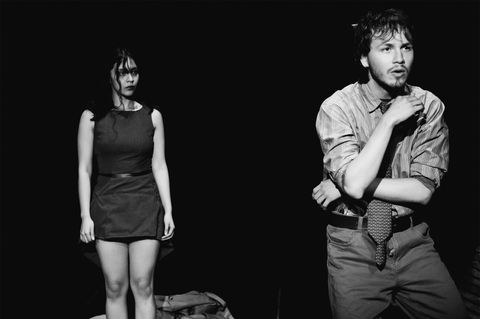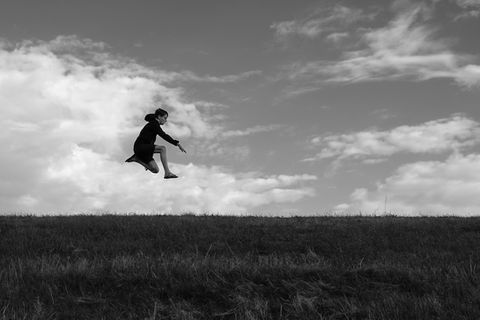
BREAKS FROM REALITY
May 20, 2022
INTERVIEW
PHOTOGRAPHY Mariëtte Aernoudts
INTERVIEW Karen Ghostlaw Pomarico
Mariëtte Aernoudts is an artist living and creating art in a small village in Raamsdonksveer, about an hour drive south of Amsterdam. Mariëtte is an autodidact photographer and image maker creating images visually depicting her own poetic world of fairytales. The magic only dreams are made of, become the reality the viewers are immersed in, when they engage the visual stories Mariëtte creates through her photography and poetic imagery.
Mariëtte would always photograph her own children, and this led to her interests in photoshop. She enjoyed making photographic montages, expanding her abilities to create these fantastical worlds where her fairytales would soon play out. Mariëtte began engaging children in her neighborhoods and in the streets to practice and experiment with this new idea of portraiture as a montage. She started working conceptually, creating a narrative for each image, often alienating her subjects creating solitary environments. Mariëtte tells us, “I am always looking for new and innovative ways to add reflections of my own feelings and emotions to my photos and aim to take the viewer just a little step beyond the ordinary.” This inner reflection adds depth and soul to her poetic fairytales.
Mariëtte was given some good advice once that has become an important thread in her work and has become part of the way Mariëtte approaches and creates her work. They told Mariëtte to only make series that are close to her, hold meaning for her. In her series of work titled OBSTACLES is a photographic autobiography that tells the visual story of living with anxiety through a series of images. Mariëtte wanted to express the consequences of anxiety in many ways. “Shall I, or Shall I Not, also known as Obstacles, was made to break through the taboo around living with anxiety. Millions of people have to deal with this, it is always hidden and in my opinion not accepted and is viewed as a sign of weakness.” Mariëtte depicts her subjects in conflict with the struggles they face, but also in the light, not darkness, exposing the realities not hiding them.
Mariëtte's trilogy of poetic images in her tryptic THE JOURNEY, conveys the whimsical story about a young girl being very curious in life. The young girl starts in the morning and her return is in the evening. “What did she experience?!? That’s totally up to the viewer to interpret,” says Mariëtte. Mariëtte brings us along for the journey allowing us to participate in the adventure.
One of Mariëtte’s favorite things in photography to explore is caching motion. The freedom of the movement elicits feelings of spirit of adventure and childlike joy in the playful acts of having fun. Mariëtte loves working with colors to express the fun depicted through these playful images saturated with a palette of hues expressive of the emotions and spirited wiles of youth.
Mariëtte has been a member of an ambitious, small photography club for the past seven years. The goal of the club is to help each other achieve a higher level of knowledge to accomplish their photographic goals. Mariëtte is challenging herself with social themes in a variety of series. She is not trying to tell her story with documentary images, but instead she creates her fairytales through symbolism and visual poetry. Mariëtte says this new work is very relaxing and has found it to be a good way to get more connectivity to nature.
I had the absolute pleasure to interview Mariëtte and this is what she shared with us at The Pictorial List to inspire you all with.

“I always want to express emotions in my photography or at least try to make people curious about the story in the photo. Often the viewer can make their own story by ‘reading’ the scene.”
IN CONVERSATION WITH MARIËTTE AERNOUDTS
THE PICTORIAL LIST: Mariëtte please tell us about yourself. How does where you are from influence your work and when did your journey into photography begin?
MARIËTTE AERNOUDTS: I was born in a little village in the south of the Netherlands. We had enough possibilities to play outside and used our imagination with the available situation without toys. In our village we had no cultural life, no cinema, no museum and at home we never discussed the subjects. Photography was not in my life at all. But I loved books, and had many adventures in the stories. Nowadays I live in a village in the middle of the country and spend my days mainly with photography in different ways: reading about it, experimenting, watching photos on the internet and I post sometimes, and also I work on commission.
My journey began by using my husband's analog camera. Mainly photographed our children, on birthdays, during holidays and special occasions. I wanted to make memories for the future as I don’t have any photo of myself as a child.
TPL: What was the first camera you ever held in your hand, brought to eye, and released a shutter on? What is the camera you use now? Does the equipment you use help you in achieving your vision in your photography?
MA: The first camera I held was an analog Yashica, don’t recall the type. I shot with an auto. Nowadays I have a Canon 5D Mark III and a Fuji TX3 which I always take along. I always shoot with my own camera settings and photography is always a challenge now to make the desired result as I see/feel things.
TPL: You create these worlds of fantasy and illusion, with poetic notes of authenticity. You often work with children as your subject. Tell us why you choose your subjects, and how they personally have influenced your work.
MA: I think I use the subjects because they bring me into a nicer world, softer and it is a little escape from reality. Children are so open and behave so naturally, I love their sincere expressions.
TPL: Nature and the environment play important roles in your work, often seeing humanity mimic nature, or your environments mimic humanity, there is a strong connection. Tell us about these connections, and how they set the stage for your portraits.
MA: Most of the time my models are selected based on their expressive faces and attitude. They are children or adults who make me feel their mood. For the portraits they don’t need a scene or setting because their expression moves me so much that this tells the whole story.
TPL: In your series ‘Obstacles’ you address the challenges one faces when they are challenged with Anxiety Disorder, tell us the passion that drives this study.
MA: In fact I myself have been managing my anxiety disorder since I was ten. It made my life a daily struggle and not many people knew about it. I lived to survive each day as good and ‘normal’ as possible but my anxiety became a hindrance in many ways. It was lonely because I thought I was the only one but through the years, talking about it, I met more and more people with the same problem. This is an underestimated problem and hard to understand. Therefore I wanted to break the taboo and shame by ‘showing’ it with my photos to achieve more understanding.
I am always looking for new and innovative ways to add reflections of my own feelings and emotions to my photos and aim to take the viewer just a little step beyond the ordinary.

TPL: Do you feel your work has therapeutic or healing qualities? Do you try to portray hope and possibilities through your studies and work?
MA: I hope so! For me my work is a way to relax, have fun making it and sometimes it makes me very happy. It would be awesome when viewers feel the same.
I always want to express emotions in my photography or at least try to make people curious about the story in the photo. Often the viewer can make an own story by ‘reading’ the scene.
TPL: You directly engage your subjects whether in eye contact or through body language, it is honest, and genuine. Tell us the importance of this.
MA: It is very important to read body language because this tells emotions of a person and all my models are always authentic and natural. I always work with them one on one, with the presence of one parent. Try to make contact as close to themselves and my emotions as possible. Before we start we have a long chat to get acquainted. Eyes are the soul of every person.
TPL: In your series of single images, light plays an inherent role in the way you illuminate and define your subject. Talk about your quality of light and what it represents in these works of art. How long has Portraiture been a subject you have studied through photography?
MA: My most used light is available light. Just a slight change of position of the head or body can make such a big difference. What I love to use is backlight to make materials like clothing or textures a bit transparent. It makes me wonder everytime when I reach this result. Light is a fantastic tool to work and play with. Sometimes the light enters a room or in plants in a way I really love and then want to catch it immediately before it will change.
Actually, since I had my children, about 36 years. It all started then. The last 13 years I have spent more and more time on it. Then I started courses and workshops. The things I want to learn I look up on the internet and experiment just as long as I know how to do them. Once it took me a year to learn an act in Photoshop!
TPL: Do you have any favorite artists or photographers you would like to share with us, and the reason for their significance?
MA: I love the light Rembrandt used in his paintings and the colors of the Italian painter Rafaël. The photo portraits of Stephan Vanfleteren impress me very much, the way he captures the emotion of people is stunning. Sally Mann inspires me by her uninhibited child photography. My favorite Dutch photographers are Danielle van Zadelhoff, Carla Kogelman and Anton Corbijn.
TPL: Are there any other photographic projects you are working on, or have planned in the near future? Where do you hope to see yourself in five years?
MA: At the moment I am working on a project with mother and child. The way to imagine the story differs sometimes but work is in progress.
In five years I hope to be healthy enough to keep on doing what I am doing now.
TPL: “When I am not out photographing, I (like to)…
MA: To take walks (not too far) together with my husband, have fun with my grandchildren and start to attend more art classes.”

Mariëtte’s photography speaks to the fantastical worlds she has created or captured in the eyes of her subjects, and often times portrayed in the body language of their gestures. Mariëtte creates her spaces with details that add intrigue to her subjects, capturing your curiosity, captivating you to, smile with them, dance and sing with them, laugh and play with them, think with them, and maybe even cry with them. When Mariëtte chooses deep dark spaces to place her subjects in, the eyes become the intrigue, asking you to look deeper, to sink into their soul.








































